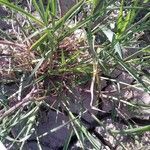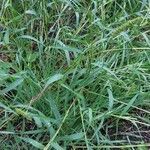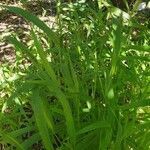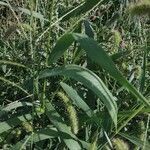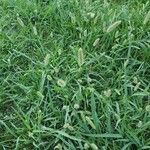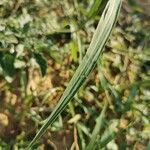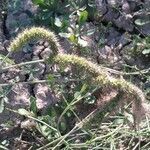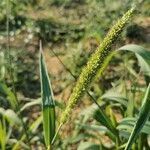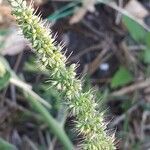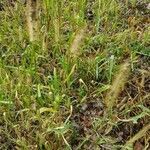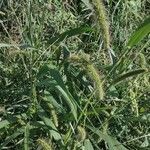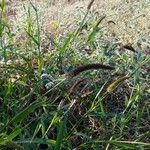Annual 3–10 dm, scabrous just beneath the infl; sheaths ciliate-margined above; blades flat, 10–25 cm × 5–15 mm, scabrous on both sides, sometimes also with scattered hairs above; infl erect, yellow-green or purplish, 5–15 cm, cylindric but lobulate, the branches verticillate, the axis scabrous-hispid on the angles, not villous; bristle one below each spikelet, 4–7 mm; spikelets 2–2.2 mm; first glume 1(–3)-veined, a third as long as the spikelet, the second 5-veined, nearly as long as the spikelet; sterile lemma nearly as long as the spikelet, clasping a rather broad palea half as long; fertile lemma transversely finely rugulose; 2n=36. Native of the Old World, now widespread in N. Amer. as a weed in gardens and greenhouses, and along the banks of streams and irrigation-ditches. Var. verticillata has the bristles retrorsely scabrous, and the axis of the panicle is retrorsely scabrous-hispid. The much less common var. ambigua (Guss.) Parl. has the bristles and panicle-axis antrorsely instead of retrorsely scabrous. (S. viridis var. ambigua)
Annual. Culms tufted, much branched, ascending, 20–100 cm tall, glabrous. Leaf sheaths thin, glabrous or papillose-pub-erulous, margins ciliolate; leaf blades broadly linear, flaccid, 5–20 × 0.4–1.8 cm, usually glabrous, base subrounded, margins scabrous, apex long acuminate; ligule 0.5–1 mm. Panicle densely spikelike, or lobed with short lateral branches on vigorous specimens, 4–15 cm, spikelets subtended by 1–4 bristles; axis shortly hispidulous; bristles green or brownish, 3–8 mm, retrorsely barbed and often becoming entangled. Spikelets elliptic, 1.8–2.4 mm, green with obvious darker veins, obtuse; lower glume 1/3–1/2 as long as spikelet, obtuse; upper glume boat-shaped, as long as spikelet, 7-veined; lower floret neuter; lower palea much reduced; upper lemma dorsally compressed, finely rugose. Fl. and fr. Jun–Sep. 2n = 18, 36.
Loosely tufted annual, 0.3-1.0 m high, often sprawling; culm node glabrous. Leaf blade 50-300 x 6-22 mm, broadly linear, usually loosely hairy, rarely glabrous; ligule a fringed membrane or a fringe of hairs. Inflorescence a spike-like panicle, 20-150 mm long, often shortly branched and interrupted in lower part; spikelets subtended by 1-4 bristles; bristles 4-16 mm long, rigid, retrorsely barbed therefore inflorescences often entangled, green tinged purple; bristles persistent on axis after spikelets falls. Spikelets 1.5-2.5 mm long, dorsiventrally compressed; lower glume 1-nerved. Florets 2; lower floret sterile, palea reduced; upper floret bisexual, lemma indurated, finely rugose, entire; anther 0.5-1.0 mm long. Flowering time Dec.-May.
Loosely tufted annual; culms 10–100 cm. high or more, geniculately ascending.. Leaf-blades broadly linear, 5–30 cm. long, 4–16 mm. wide, flaccid, glabrous to loosely pilose; sheaths glabrous to pubescent.. Panicle spiciform, linear to untidily lobed, 2–15 cm. long, often entangled, the rhachis hispidulous; bristles 3–8 mm. long, retrorsely barbed, tenaciously clinging.. Spikelets ellipsoid, 1.5–2.5 mm. long; lower glume 1/3–1/2, the upper as long as the spikelet; lower floret sterile, the palea minute; upper lemma finely rugose.. Fig. 127.
Loosely tufted annual 300-1 000 mm high, often sprawling; culm node glabrous. Leaf blade 50-300 x 6-22 mm, broadly linear, usually loosely hairy, rarely glabrous; sheath margin hairy or glabrous. Inflorescence 20-150 mm long, spike-like, often shortly branched and interrupted in lower part; bristles 1-4, 4-16 mm long, rigid, retrorsely barbed therefore inflorescences often entangled, green tinged purple. Spikelet 1.5-2.5 mm long; lower glume 1-nerved; lower floret sterile, palea reduced; upper lemma finely rugose; anther 0.5-1.0 mm long.
Annual; up to 1 m high; loosely tufted. Culms often sprawling. Leaf blades 50-300 x 6-22 mm. Flowers: panicle spike-like; often shortly branched and interrupted in lower part; 20-150 mm long; spikelets 1.5-2.5 mm long; bristles retrorsely barbed; often entangled; lower glume 1-nerved; upper glume 3-5-nerved.
Annual, loosely tufted (often sprawling), up to 1 m high. Leaf blades 50-300 mm long, 6-22 mm wide. Spikelets 1.5-2.5 mm long. Panicle spike-like, often shortly branched and interrupted in lower part, 20-150 mm long; bristles retorsely barbed, often entangled; lower glume 1-nerved.
An annual grass. It forms tufts. It has many branches. It is 20-100 cm tall. The flower is narrow and like a cylinder shaped. It tapers to a point. The spikelets are in rings and separated especially lower on the flowering stalk. The bristles are barbed in a reflexed direction.
Annual, often sprawling, to 1 m. Leaves linear-lanceolate. Spikelets 1.5-2.5 mm, in a spike-like panicle often shortly branched and interrupted below, bristles 1-4 per cluster, retrorsely barbed and often tangled, lower glume 1-nerved.
Panicle 2–15 cm. long, spiciform, linear to untidily lobed, often entangled, the rhachis hispidulous; bristles 3–8 mm. long, retrorsely barbed, tenaciously clinging.
Culms 50–100 cm. high or more, geniculately ascending.
Inferior floret sterile, the palea minute.
Spikelets 1.5–2.5 mm. long, elliptic.
Superior glume as long as spikelet.
Ascending annual up to 1 m. high
Superior lemma finely rugose.
Loosely tufted annual.
